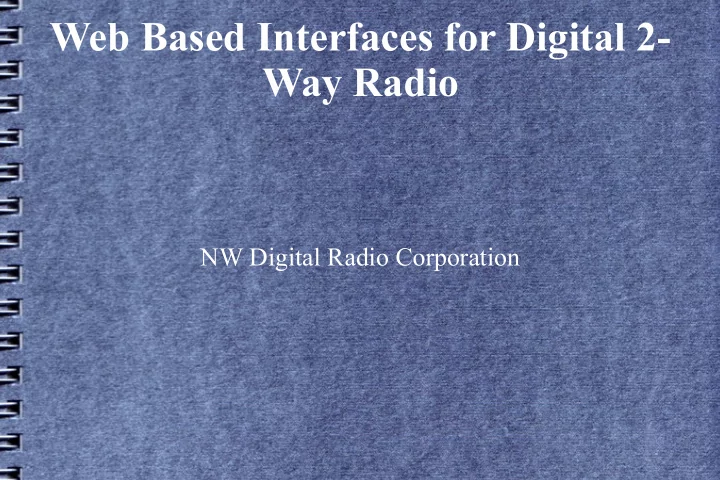

Web Based Interfaces for Digital 2- Way Radio NW Digital Radio Corporation
Our Market ● Amateur (Ham) Radio Operators – Emergency Communications Support ● Digital Data (Messaging), Digital Voice ● Ad-Hoc Networking – Situational Awareness ● Geolocation – Experimentation ● New Modulation Techniques ● New Protocols –
Radio Design ● 30 Watts UHF (430-450 Mhz.) ● Embedded ARM Based Computing Platform ● I/Q 2-point Modulation and Detection ● Ethernet ● 4 Host USB Ports ● Software Defined Modems (Socket Interface) ● Software Defined Protocols (Socket Interface) ● Embedded Applications on Linux OS (Debian)
Configuration and Control ● No Physical Controls ● All Control is Via Network (Ethernet, WiFi, etc.) – Frequency – Power – Protocol – Modulation
Monitor and Communicate ● Monitor – Environment – Performance (RSSI and BER) ● Voice and Data I/O – Streamed – Packet Switched
The Software Challenge ● Sockets to Hardware for Control and Monitoring ● Sockets to Multi-Stage Pipeline – Voice and/or Data – Protocol – Modem – RF – Configuration and Transport ● No / Low Jitter Streaming for Digital Voice
The Software Challenge ● Target Rich Clients – Multiple Operating Systems / Environments – Smart Phones, Tablets, Desktops, Purpose Built – I18n / Support for Disabilities ● Inter-Application Data Streams – On Processor – Over Internet – No UI Endpoint
Websockets ● Started by learning about Websockets – Full interaction between modern browsers and web application – Useable with non-web GUI elements – Implemented some crude applications – Required intimate knowledge – Gave some of the functionality needed
node.js to the Rescue ● Discovered node.js as a framework Fall 2012 ● Provided a container and the use of JavaScript – Server – Client ● Introduction to programmers ● Much quicker implementations with reusable design patterns
“Packet Capture” ● Existing network based programs use well known or configurable ports ● Use “pcap” module – Leaverage pcap filters from tcpdump ● Capture packets (UDP or TCP) – Protocol handlers (D-STAR / APRS) – Events update model in app – Push model state as JSON to “subscribers”
Endpoint Socket Communications ● Open sockets to applications and modules – Use “dgram” module – Communication ● Exchange streams ● Data and Configuration ● Authentication – Use “crypto” module ● Monitor and Control Radio
Web Interfaces ● Use socket.io to abstract transport – Pass JSON objects bidirectionally – Replicate state model on server and web ● Update via JSON objects ● Use http or express to manage presentation path – Light HTML with JavaScript DOM modification – Do not use JADE or other layout languages ● Manage sessions for multiple users
Shared Model ● Multiple clients in application(s) – Endpoint sockets – Packet capture ● Server for Web/socket.io clients ● Data is passed between clients and server using shared objects within the application. – Queues – Events
Questions
Recommend
More recommend